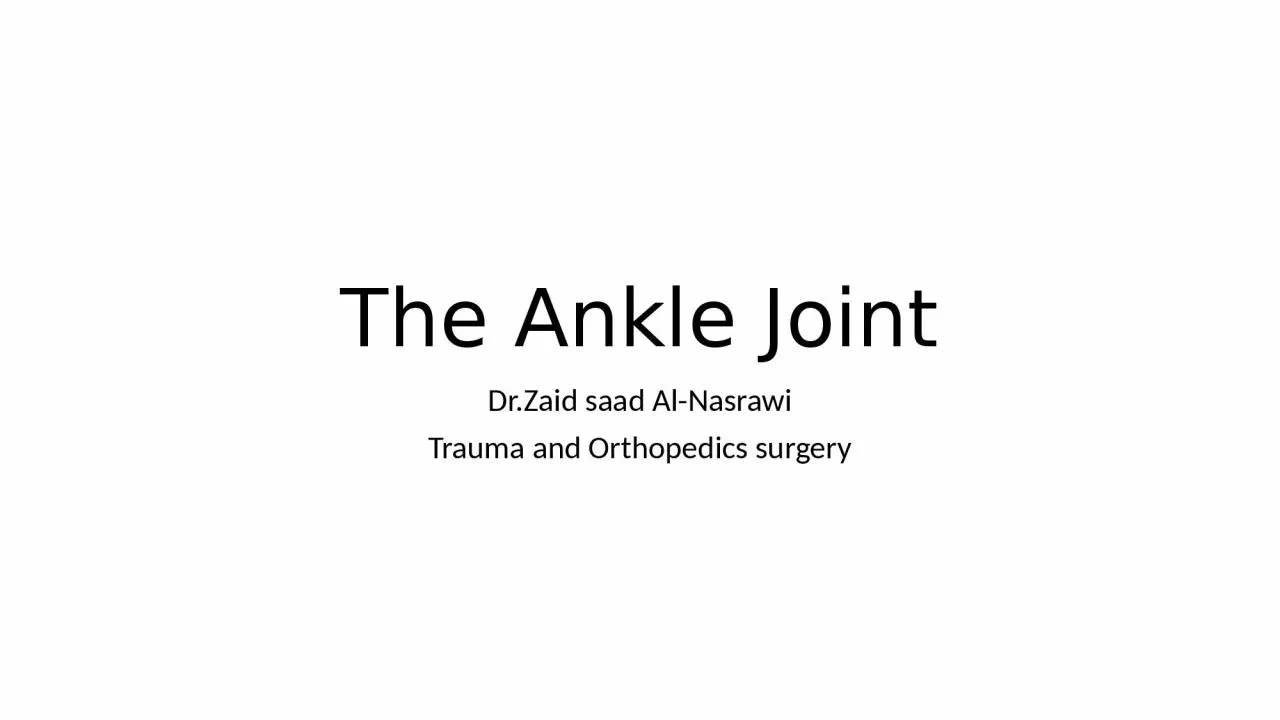

Trauma and Orthopedics surgery Anatomy of the Ankle Joint The ankle joint is a synovial hinge joint Articular surfaces the lower tibia and the inner surface of the medial malleolus the medial surface of the lateral malleolus of the fibula ID: 935256
Download Presentation The PPT/PDF document "The Ankle Joint Dr.Zaid saad Al-Nasrawi" is the property of its rightful owner. Permission is granted to download and print the materials on this web site for personal, non-commercial use only, and to display it on your personal computer provided you do not modify the materials and that you retain all copyright notices contained in the materials. By downloading content from our website, you accept the terms of this agreement.
Slide1
The Ankle Joint
Dr.Zaid saad Al-Nasrawi
Trauma and Orthopedics surgery
Slide2Anatomy of the Ankle Joint
The
ankle joint is a synovial hinge joint
Articular surfaces: the lower tibia and the inner surface of the medial malleolus. the medial surface of the lateral malleolus of the fibula. the trochlear surface of the head of the talus
Slide3The articular surface of the talus is
broader anteriorly than posteriorly
This makes the ankle more stable in dorsiflexion (
i e standing) and more mobile in plantar flexion
Capsule This is attached to the margins of the articular surfaces, except where it extends distally to the neck of the
talus
Synovium This lines the capsule and frequently passes up between the lower ends of the tibia and the fibula
Slide4Ligaments
The capsule of the ankle joint is thickened with ligaments medially and laterally but is weak anteriorly and
posteriorly
The deltoid ligament is a triangular ligament on the medial aspect of the ankle It is attached to the apex of the medial malleolus and inferiorly to the medial aspect of the talus, the sustentaculum tali of the calcaneus and the tuberosity of the navicular
Slide5Laterally, the ankle is strengthened by three ligaments:
the
posterior
talofibular ligament , which passes medially from the lowest part of the malleolar fossa of the fibula to the posterior process of the talus.the calcaneofibular ligament , which passes from the apex of the lateral malleolus to the calcaneus.the anterior talofibular
ligament
, which passes
anteromedially from the lateral malleolus to the lateral aspect of the neck of the talus
Slide6Radiological features of the ankle joint
Slide7Slide8Plain radiographs
of Ankle joint
On AP radiographs
The tibiotalar surfaces are seen to be parallel to each other and perpendicular to the shaft of the tibia.The articular surfaces of the malleoli on each side are symmetrical about a line through the shaft of the tibia, each making an equal angle with the inferior surface of the tibia
Slide9X ray on Stress View
The
medial and lateral ligaments of the ankle joint
are not visible on plain radiographs.Stress views Where the distance between the medial malleolus and the talus is increased ,this means disruption of the deltoid ligament. Where there is increased distance between the lateral malleolus and the talus without bony injury this is due to disruption of the lateral
ligaments.
Slide10Trimalleolar fracture
The term
trimalleolar
fracture is sometimes used, although there are only two malleoli The third ‘ malleolus ’ is the posterior lip of the tibial articular surface
Slide11Arthrography
The
synovial cavity is outlined by injection of contrast and the integrity of the medial and lateral ligaments can be assessed The normal articular surfaces are seen to be smooth and parallel Computed tomographyThis
can be combined with arthrography to assess the bony components of the ankle
joint
Direct coronal and axial images are routinely acquired in slices 2 mm thick
Slide12Magnetic resonance imaging
This technique is particularly useful for soft tissues, especially ligaments and
tendons.
The Achilles tendon can be seen inserting into the posterior aspect of the calcaneus, separated from the posterior surface of the tibia by a fat pad
The
cartilaginous surface of the articulating bones can be visualized
directly.
Slide13The ankle ligaments
There are four major ligamentous stabilizers in the foot and ankle:
the
lateral collateral ligament. the medial collateral ligament (the deltoid ligament
).
the syndesmotic complex
and
the
interosseous
ligament (
talocalcaneal
ligament) in the sinus tarsi
Slide14The syndesmosis
.
Syndesmosis
is the term used to describe the three stabilizing components of the inferior tibiofi bular articulation: the anterior and posterior tibiofi bular
ligaments (ATIF, PTIF) and the
interosseous
membrane Injury to the syndesmosis is extremely uncommon in the absence of a fracture
Injury to the
syndesmosis
usually involves rupture to the
anterior
tibiofi
bular
ligament and spares the posterior.
Slide15The Achilles tendon
Formed
by merging of the
gastrocnemius and soleus tendons, the Achilles tendon extends inferiorly to insert on the dorsal margin of the calcaneus It is readily visualized on both ultrasound and MRI in the sagittal plane